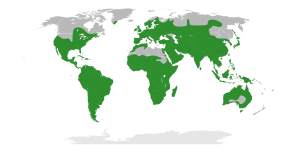Category:Polygalaceae
| Polygalaceae | |
|---|---|

| |
| Securidaca longipedunculata | |
| Scientific classification | |
| Kingdom: | |
| (unranked): | |
| (unranked): | |
| (unranked): | |
| Order: | |
| Family: | Polygalaceae |
| Type genus | |
| Polygala L. 1753
| |
| Tribes and Genera | |
| |

| |
| Distribution of the Polygalaceae. | |
| Synonyms | |
| |
The Polygalaceae or the milkwort family are made up of flowering plants in the order Fabales. They have a near-cosmopolitan range, with about 21 genera and ca. 900 known species[2] of herbs, shrubs and trees. Over half of the species are in one genus, Polygala, the milkworts.
Under the Cronquist classification system, Polygalaceae were treated in a separate order of their own, Polygalales. Currently, according to the Angiosperm Phylogeny Group, the family belongs in Fabales.
Tribes and genera
The Polygalaceae comprise the following genera:[3][4][5][6][7][8]
Carpolobieae
- Atroxima Stapf 1905
- Carpolobia G. Don 1831
Moutabeae
- Balgoya Morat & Meijden 1991
- Barnhartia Gleason 1926
- Diclidanthera Mart. 1827
- Eriandra P. Royen & Steenis 1852
- Moutabea Aubl. 1775
Polygaleae
- Acanthocladus Klotzsch ex Hassk. 1864
- Ancylotropis B. Eriksen 1993
- Asemeia Raf. 1833
- Badiera DC. 1824
- Bredemeyera Willd. 1801
- Caamembeca J.F.B. Pastore 2012
- Comesperma Labill. 1807
- Epirixanthes Blume 1823
- Gymnospora (Chodat) J.F.B. Pastore 2013
- Hebecarpa (Chodat) J.R. Abbott 2011
- Heterosamara Kuntze 1891
- Hualania Phil. 1862
- Monnina Ruiz & Pav. 1798
- Muraltia DC. 1815
- Phlebotaenia Griseb. 1860
- Polygala L. 1753
- Polygaloides Haller 1768
- Rhinotropis (S.F. Blake) J.R. Abbott 2011
- Salomonia Lour. 1790
- Securidaca L. 1759
Xanthophylleae
- Xanthophyllum Roxb. 1820
Fossils
- †Deviacer Manchester
- †Paleosecuridaca Pigg, Kathleen B., M.L. DeVore & M.F. Wojc. 2008
Systematics
Modern molecular phylogenetics suggest the following relationships:[8][9][10][11][12][13]
|
| |||||||||||||||||||||||||||||||||||||||||||||||||||||||||||||||||||||||||||||||||||||||||||||||||||||||||||||||||||||||||||||||||||||||||||||||||||||||||||||||||||||||||||||||
References
- ↑ Angiosperm Phylogeny Group (2009). "An update of the Angiosperm Phylogeny Group classification for the orders and families of flowering plants: APG III" (PDF). Botanical Journal of the Linnean Society. 161 (2): 105–121. doi:10.1111/j.1095-8339.2009.00996.x. Retrieved 2013-07-06.
- ↑ Christenhusz, M. J. M. & Byng, J. W. (2016). "The number of known plants species in the world and its annual increase". Phytotaxa. Magnolia Press. 261 (3): 201–217. doi:10.11646/phytotaxa.261.3.1.
- ↑ Abbott JR. (2011). "Notes on the disintegration of Polygala (Polygalaceae), with four new genera for the flora of North America". Journal of the Botanical Research Institute of Texas. 5 (1): 125–137. JSTOR 41972495.
- ↑ Pastore JFB. (2012). "Caamembeca: Generic status and new name for Polygala subgenus Ligustrina (Polygalaceae)". Kew Bull. 67 (3): 435–442. doi:10.1007/s12225-012-9360-x.
- ↑ Pastore JFB, Rodrigues de Moraes PL. (2013). "Generic status and lectotypifications for Gymnospora (Polygalaceae)". Novon. 22 (3): 304–306. doi:10.3417/2010113.
- ↑ Abbott JR, Pastore JFB (2015). "Preliminary synopsis of the genus Hebecarpa (Polygalaceae)". Kew Bull. 70: 39. doi:10.1007/s12225-015-9589-2.
- ↑ Freire-Fierro A. (2015). Systematics of Monnina (Polygalaceae) (Ph.D.). Drexel University.
- ↑ 8.0 8.1 Pastore JFB, Abbott JR, Neubig KM, Whitten WM, Mascarenhas RB, Almeida Mota MC, van den Berg C. (2017). "A molecular phylogeny and taxonomic notes in Caamembeca (Polygalaceae)". Syst Bot. 42 (1): 54–62. doi:10.1600/036364417X694935.
- ↑ Persson C. (2001). "Phylogenetic relationships in Polygalaceae based on plastid DNA sequences from the trnL–F region". Taxon. 50 (3 (Golden Jubilee Part 5)): 763–779. doi:10.2307/1223706. JSTOR 1223706.
- ↑ Forest F, Chase MW, Persson C, Crane PR, Hawkins JA. (2007). "The role of biotic and abiotic factors in evolution of ant dispersal in the milkwort family (Polygalaceae)". Evolution. 61 (7): 1675–1694. doi:10.1111/j.1558-5646.2007.00138.x.
- ↑ Bello MA, Bruneau A, Forest F, Hawkins JA. (2009). "Elusive relationships within order Fabales: Phylogenetic analyses using matK and rbcL sequence data". Syst Bot. 34 (1): 102–114. doi:10.1600/036364409787602348.
- ↑ Abbott JR. (2009). Phylogeny of the Polygalaceae and a revision of Badiera (PDF) (Ph.D.). University of Florida.
- ↑ Mennes CB, Moerland MS, Rath M, Smets EF, Merckx VSFT. (2015). "Evolution of mycoheterotrophy in Polygalaceae: The case of Epirixanthes". Am J Bot. 102 (4): 598–608. doi:10.3732/ajb.1400549.
External links
Acknowledgements
This article uses material from the Wikipedia article Polygalaceae, which is released under the Creative Commons Attribution-Share-Alike License 3.0.
Pages in category "Polygalaceae"
The following 2 pages are in this category, out of 2 total.